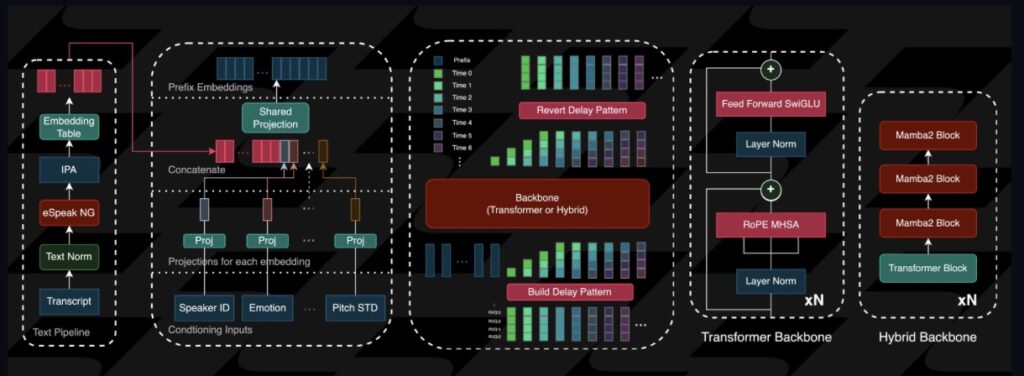How a 1.6B-Parameter AI Is Challenging Big Tech With Zero-Shot Cloning, Multilingual Mastery, and Emotion Control
- Open-Source Powerhouse: Zonos-v0.1 is a lightweight, 100% open-source AI model that clones voices in seconds and runs efficiently on consumer-grade GPUs.
- Multilingual & Emotionally Intelligent: Trained on 200k+ hours of multilingual data, it generates expressive speech in 5 languages while letting users fine-tune pitch, speed, and emotions like anger or joy.
- Developer-Friendly Innovation: With Docker deployment, Gradio WebUI, and real-time 44kHz audio generation, Zonos democratizes high-quality text-to-speech for creators and enterprises alike.

Voice cloning technology has long been dominated by proprietary systems from tech giants—until now. Enter Zonos, a groundbreaking open-source AI model that packs state-of-the-art speech synthesis into a lean 1.6 billion-parameter framework. Designed to run on modest hardware while delivering studio-quality 44kHz audio, Zonos isn’t just challenging the status quo—it’s rewriting the rules.
Why Zonos Changes the Game
1. Zero-Shot Cloning Made Simple
Forget hours of training data. Zonos requires just 10–30 seconds of audio to clone a voice with startling accuracy. Whether mimicking a celebrity’s tone or recreating a loved one’s speech patterns, its hybrid transformer architecture combines text prompts with speaker embeddings or audio prefixes for hyper-realistic output. The model even handles nuanced behaviors like whispering by analyzing audio context, a feature most closed systems struggle to replicate.
2. Multilingual Mastery and Emotional Depth
Zonos-v0.1 speaks English, Japanese, Chinese, French, and German fluently, thanks to its 200,000-hour training dataset spanning diverse accents and dialects. But what truly sets it apart is its emotional intelligence. Users can dial in specific emotions—happiness, fear, sadness, anger—or adjust technical parameters like pitch variation and speaking rate. This granular control makes it ideal for applications ranging from audiobook narration to emotionally responsive AI assistants.
3. Built for Developers, Loved by Creators
Zonos prioritizes accessibility. Its Docker-based installation works seamlessly on Linux systems with NVIDIA GPUs (RTX 3000-series or newer), and the included Gradio WebUI lets even non-coders experiment with voice generation. With a real-time factor of 2x on an RTX 4090, it’s fast enough for live applications.
Under the Hood: How Zonos Works
Zonos’s architecture combines proven tools with cutting-edge innovation:
- Text Processing: Uses eSpeak for phonemization, converting raw text into standardized speech sounds.
- Token Prediction: A transformer or hybrid backbone generates DAC tokens, which are decoded into high-fidelity audio.
- Quality Control: Advanced conditioning lets users prioritize clarity over speed or inject raw emotional resonance.
Real-World Applications
From indie game studios adding dynamic NPC voices to filmmakers restoring historical speeches, Zonos unlocks possibilities once reserved for big-budget projects. Educators can generate multilingual lesson materials, while healthcare providers might replicate patient-specific voices for those with speech impairments. Even content creators can produce podcast intros or YouTube narrations without expensive software.
Zonos isn’t just a tool—it’s a movement. By open-sourcing its weights and architecture, the developers at Zyphra have ignited a community-driven push toward ethical, transparent voice technology. As the model evolves, expect expansions into more languages, reduced hardware requirements, and even finer emotional granularity.
